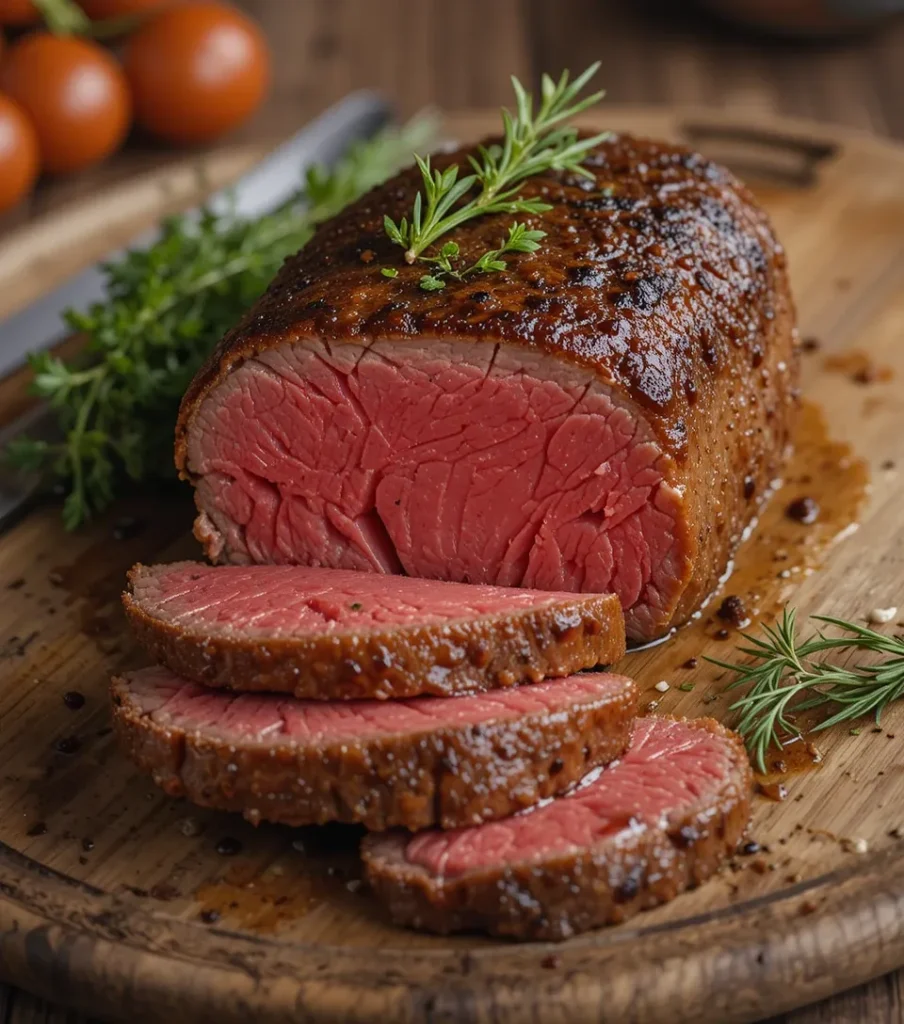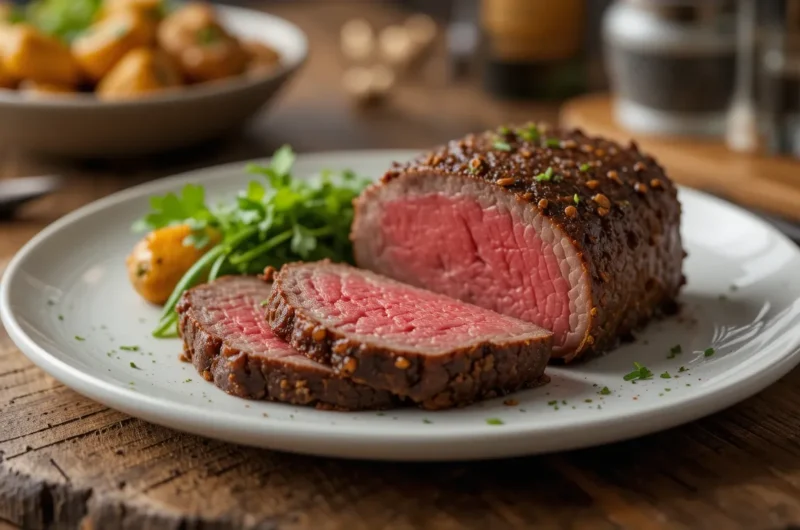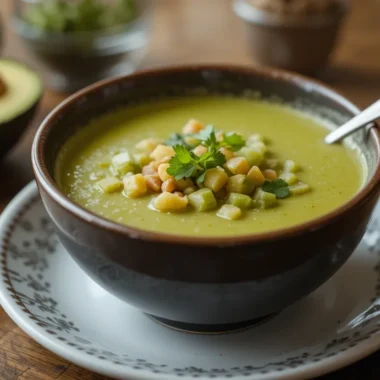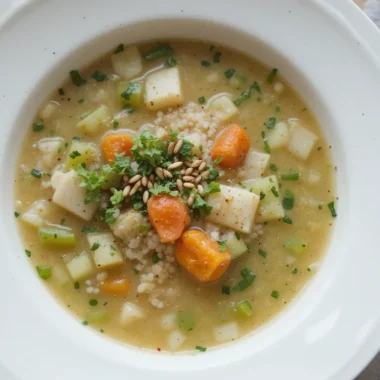When the beef tenderloin comes out of the oven, it fills the kitchen with a mouthwatering smell. You know you’re making something special. This prime cut is the top of culinary excellence, turning simple dinners into unforgettable meals.
Beef tenderloin is more than just a meal; it’s an experience. It’s the most tender cut, lean and luxurious, promising restaurant-quality results at home. Whether it’s for a special dinner or just a great meal, mastering beef tenderloin will boost your cooking.
Imagine serving a perfectly cooked, juicy beef tenderloin that wows your guests. With the right techniques, you can make this high-end cut into a culinary masterpiece. It will look and taste like it was made by a pro.
Table of Contents
Understanding Beef Tenderloin: The King of Cuts
The tenderloin is the top choice for premium beef. It’s known for its soft texture and tenderness. This makes it a hit with steak lovers and chefs.

Beef tenderloin is special because of its location and low activity. This results in a soft texture that’s a joy to eat. The filet mignon, a part of the tenderloin, is the ultimate luxury in beef.
What Makes Tenderloin Special
- Unparalleled tenderness
- Minimal fat content
- Mild, delicate flavor
- Versatile cooking options
Different Cuts and Grades
Beef tenderloin has various cuts for different tastes:
- Chateaubriand: A thick, center-cut portion perfect for roasting
- Filet mignon: Small, thick steaks ideal for individual servings
- Tail end: Smaller, less uniform cuts great for various recipes
Selecting the Best Quality
When picking a steak, consider these important points:
- Look for USDA Prime grade for maximum marbling
- Check for bright red color
- Ensure consistent thickness for even cooking
- Seek out fresh, well-trimmed cuts
Pro tip: The USDA grading system helps you find the best beef. Prime is the highest grade, with great marbling and flavor. It makes your steak experience better.
Essential Preparation Techniques
Preparing beef tenderloin needs careful attention to get it juicy and flavorful. The process starts long before cooking. Several key steps can make your roast truly special.
First, thaw your beef tenderloin in the fridge for at least 48 hours. Then, take it out 1-2 hours before cooking. This lets it reach room temperature, ensuring even cooking.
Key Preparation Steps
- Trim excess fat and remove the silver skin using a sharp knife
- Pat the meat dry with paper towels to improve marinating and browning
- Season generously with coarse salt and freshly ground pepper
- Consider dry brining by salting the meat and letting it rest uncovered overnight
Marinating can greatly enhance your beef tenderloin’s taste. Create a simple marinade with olive oil, garlic, balsamic vinegar, and fresh herbs. Marinate for 30 minutes to 24 hours in the fridge. This adds flavor and makes the meat tender and juicy.
Professional chefs suggest using a meat thermometer to check doneness. Aim for medium-rare at 130-135°F for the best taste and tenderness. After cooking, let your tenderloin rest for 15-20 minutes. This ensures the juices are evenly distributed, making it supremely juicy.
Perfect Seasoning Methods for Beef Tenderloin
Improving your cooking skills starts with seasoning beef tenderloin right. The right mix of herbs, spices, and methods can make a great cut of meat even better.
Seasoning this top-notch cut needs precision. You want to boost the meat’s natural taste without making it too strong.
Basic Salt and Pepper Technique
The key to great cooking is simple seasoning. For beef tenderloin, use:
- Coarse kosher salt
- Freshly ground black pepper
- Apply half the salt directly on the beef before marinating
Herb and Garlic Combinations
Boost your seasoning with a strong herb mix that goes well with the tenderloin’s rich taste:
| Ingredient | Quantity |
|---|---|
| Minced Garlic | 1/2 tablespoon |
| Dried Rosemary | 1/2 teaspoon |
| Onion Powder | 1 teaspoon |
| Dried Parsley | 1/2 tablespoon |
Marinade Options
Make a gourmet cooking marinade by mixing:
- Olive oil
- Fresh garlic
- Fresh rosemary
- Fresh thyme
- Onion powder
- Ground black pepper
- Kosher salt
Pro tip: Rub the marinade all over the beef tenderloin for even flavor. Use a meat thermometer for perfect doneness every time.
Temperature and Timing Guidelines
Mastering the art of roasting beef tenderloin requires precision and understanding of temperature control. Your goal is to achieve a melt-in-mouth experience. This transforms an ordinary meal into an extraordinary culinary delight.
The internal temperature is key for creating that perfect tenderloin texture. Here are the key temperature ranges to ensure a delicious result:
- Rare: 120°F to 125°F
- Medium-Rare: 125°F to 130°F (recommended)
- Medium: 135°F to 140°F
- Well-Done: 145°F and above
Roasting techniques vary based on your preferred cooking method. Different approaches require specific temperature management to guarantee optimal results.
| Cooking Method | Oven Temperature | Cooking Time | Resting Time |
|---|---|---|---|
| High-Heat Method | 475°F | 45 minutes | 20 minutes |
| Low-Heat Method | 225°F | 95 minutes | 10 minutes |
| Charcoal/Gas Grill | Medium-High | 20-25 minutes | 15 minutes |
Pro tip for roasting: Always use a reliable meat thermometer and insert it ¼ inch below the surface. Remember that carryover cooking will continue to raise the internal temperature by about 5°F after removing the meat from heat.
The secret to a melt-in-mouth beef tenderloin is patience. Allow your roast to rest, letting the juices redistribute. This ensures maximum tenderness and flavor.
Classic Garlic-Rosemary Beef Tenderloin Recipe
Grilling a perfect beef tenderloin needs skill and precision. This classic recipe turns a top-notch cut of meat into a memorable meal. It will wow your family and guests.
Making a restaurant-quality beef tenderloin at home is simpler than you think. With the right ingredients and careful cooking, you can make a tender, flavorful roast. It will be as good as any steakhouse.
Ingredients List
- 2-pound beef tenderloin roast (trimmed and tied)
- 1 tablespoon olive oil
- 1 tablespoon fresh rosemary, minced
- 3 cloves garlic, grated
- 2 teaspoons kosher salt
- 1 teaspoon black pepper
Step-by-Step Instructions
- Preheat your oven to 425°F
- Pat the beef roast dry with paper towels
- Mix olive oil, rosemary, garlic, salt, and pepper in a small bowl
- Rub the herb mixture evenly across all sides of the roast
- Insert a digital meat thermometer in the thickest part
- Roast for 35-45 minutes until internal temperature reaches 135°F for medium-rare
- Let the meat rest for 10 minutes before serving
Tips for Perfect Results
Grilling success comes from careful temperature monitoring and letting the meat rest. Use an instant-read thermometer for exact doneness. Let the tenderloin rest to redistribute juices.
| Doneness | Internal Temperature | Resting Time |
|---|---|---|
| Rare | 125°F | 10 minutes |
| Medium-Rare | 135°F | 10-15 minutes |
| Medium | 145°F | 15 minutes |
Pro tip: Always bring your beef tenderloin to room temperature before grilling to ensure even cooking.
Reverse Sear Method for Tender Results
The reverse sear method turns your beef tenderloin into a culinary masterpiece. It ensures a juicy texture that will wow even the pickiest eaters. This method flips the traditional roasting rules on their head.
Here’s how the reverse sear method works to create an exceptionally tender beef tenderloin:
- Start by cooking the meat at an extremely low temperature (225°F)
- Slowly bring the internal temperature to 120°F (takes 60-70 minutes)
- Rest the roast for 10-15 minutes
- Finish with a high-heat sear to create a perfect golden crust
The secret to a perfect juicy texture is precise temperature control. An instant-read thermometer is your best kitchen friend during this process. By roasting slowly and finishing with a quick sear, you’ll get a beef tenderloin with an edge-to-edge color and remarkable consistency.
Temperature guidelines for your reverse sear adventure:
- Rare: 120-125°F (bright red center)
- Medium Rare: 130-135°F (dark pink center)
- Medium: 140-145°F (pink center)
Pro tips for mastering the reverse sear method include using high-heat oil for searing and allowing adequate resting time between cooking stages. This technique guarantees a restaurant-quality beef tenderloin right in your own kitchen. It will make your guests marvel at your culinary skills.
Sauces and Accompaniments
To make your beef tenderloin truly special, choose the right sauce and side dishes. Gourmet cooking is about mixing flavors that match the meat’s richness and tenderness.
Classic Sauce Pairings
Traditional sauces add a special touch to your beef tenderloin. Béarnaise sauce is a top pick, made with:
- Fresh tarragon
- Egg yolks
- White wine vinegar
- Melted butter
Modern Sauce Variations
Modern cooking brings new sauce ideas that make your beef tenderloin even better. Try these modern options:
- Gremolata: A zesty Italian mix of parsley, lemon zest, and garlic
- Truffle butter sauce
- Chimichurri
Wine Pairing Suggestions
| Sauce Type | Recommended Wine |
|---|---|
| Béarnaise | Cabernet Sauvignon |
| Red Wine Reduction | Merlot |
| Gremolata | Pinot Noir |
Pro tip: Make your sauce up to three days ahead and chill it. This boosts flavors and saves prep time.
Storing and Reheating Tips
Keeping your steak fresh after cooking is key. You need to store and reheat it right. This way, your tenderloin stays tasty and tender for days.
Refrigeration Best Practices
Here’s how to store your leftover steak:
- Wrap each piece of beef tenderloin individually in freezer paper
- Place wrapped pieces in a heavy-duty freezer bag
- Remove as much air as possible before sealing
- Store on the bottom shelf of the refrigerator
Storage Duration and Safety
Your cooked steak can stay in the fridge for 3-4 days. Keep it fresh by using an airtight container or wrapping it tightly. This stops moisture loss.
| Storage Method | Maximum Storage Time | Recommended Technique |
|---|---|---|
| Refrigerator | 3-4 days | Airtight container or tight wrapping |
| Freezer | 2-3 months | Freezer paper, sealed bag, air removed |
Reheating Without Losing Quality
Don’t use the microwave, as it can dry out your steak. Try these gentle reheating methods instead:
- Remove steak from refrigerator 45 minutes before reheating
- Preheat oven to low temperature (250°F)
- Place steak on a baking sheet
- Heat until internal temperature reaches 110°F
- Let rest for 5 minutes before serving
By using these tips, your beef tenderloin will stay delicious, just like the first time you cooked it.
Common Cooking Mistakes to Avoid
Roasting beef tenderloin needs precision and careful attention. Even skilled home chefs can make common mistakes. These mistakes can ruin the quality of this premium cut. Knowing these pitfalls will help you make a perfectly cooked, juicy tenderloin every time.
Preparing beef tenderloin requires technical skill and knowledge. The most critical errors can turn your expensive cut into a disappointing meal.
Temperature Control Errors
Temperature management is key when roasting beef tenderloin. Common mistakes include:
- Starting with cold meat, which prevents even cooking
- Using an inaccurate oven thermometer
- Not preheating the cooking surface
Experts say to let beef reach room temperature for 30-60 minutes before roasting. A reliable meat thermometer ensures perfect doneness.
Resting Time Mistakes
Cutting into the meat right after roasting is a big mistake. Proper resting allows juices to redistribute. This makes the meat tender and flavorful.
| Resting Time | Meat Weight |
|---|---|
| 10-15 minutes | 2-3 pound tenderloin |
| 15-20 minutes | 4-5 pound tenderloin |
Seasoning Issues
Seasoning can make or break your roasting experience. Avoid these common mistakes:
- Under-seasoning the meat
- Using overpowering spice blends
- Not patting the meat dry before seasoning
Season liberally with salt and pepper. Focus on creating a balanced flavor that enhances the tenderloin’s natural taste.
Conclusion
You’ve learned how to cook beef tenderloin like a pro. This expensive cut can now be a top-notch dish. You’ve discovered the art of choosing the right cut and mastering cooking techniques.
Beef tenderloin is more than food; it’s a special experience. It requires skill and love. You’ve learned to prepare it in many ways, from roasting to reverse searing.
Respecting the meat’s tenderness and flavor is key. Whether it’s for a big dinner or a cozy night in, your beef tenderloin will always impress. You’ve gained the knowledge to make every dish exceptional.
Keep practicing to get better. Each time you cook, you’ll learn more about temperature, seasoning, and resting. Soon, your steaks will be as good as those in fancy steakhouses, all from your kitchen.
Your adventure with beef tenderloin is just starting. Keep trying new things like different seasonings and cooking methods. This will help you find your own special way to cook this amazing meat.
FAQ
What is the difference between beef tenderloin and filet mignon?
Beef tenderloin is the whole muscle from which filet mignon steaks are cut. Filet mignon is the tender part from the center. Not all tenderloin is filet mignon, but all filet mignon comes from it. Tenderloin is larger and can be roasted whole, while filet mignon are steaks.
How do I choose the best quality beef tenderloin?
Look for marbling, a bright red color, and firm texture in beef tenderloin. Choose Prime or Choice grade for quality. The meat should be fresh and have minimal moisture. Buying from a reputable butcher helps in selecting the best cut.
What is the recommended internal temperature for different levels of doneness?
Here are the internal temperatures for different doneness levels:
– Rare: 125°F (52°C)
– Medium Rare: 135°F (57°C)
– Medium: 145°F (63°C)
– Medium Well: 150°F (66°C)
– Well Done: 160°F (71°C)
Always use a meat thermometer. The temperature will rise slightly during resting.
How long should I let the beef tenderloin rest before carving?
Let the beef tenderloin rest for 10-15 minutes after cooking. This ensures juicy and tender meat. Cover it loosely with foil to keep it warm.
Can I prepare beef tenderloin in advance?
Yes, you can prepare beef tenderloin in advance. Trim and season it up to 24 hours before. Bring it to room temperature for 30-60 minutes before cooking for even cooking.
What are the best methods for cooking beef tenderloin?
Excellent methods for cooking beef tenderloin include:
– Oven Roasting: Traditional method for even cooking
– Reverse Sear: Slow-roast then high-heat sear for perfect doneness
– Grilling: Direct and indirect heat combination
– Sous Vide: Precise temperature control for consistent results
Choose based on your equipment and desired outcome.
How do I prevent beef tenderloin from drying out?
To prevent drying out:
– Bring meat to room temperature before cooking
– Use a meat thermometer to avoid overcooking
– Let the meat rest after cooking
– Consider using marinades or dry brining
– Cook at the right temperature
– Use the reverse sear method for more consistent results
What are the best sauces to serve with beef tenderloin?
Classic sauces for beef tenderloin include:
– Béarnaise Sauce – Red Wine Reduction – Horseradish Cream – Chimichurri – Truffle Butter
Choose a sauce that complements the meat’s flavors.
Did You Try This Recipe ?
There are no reviews yet. Be the first one to write one.









Pingback: beef brisket recipe